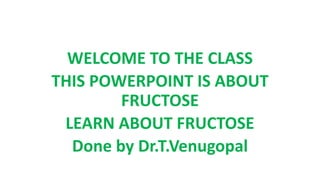
Fructose
- 1. WELCOME TO THE CLASS THIS POWERPOINT IS ABOUT FRUCTOSE LEARN ABOUT FRUCTOSE Done by Dr.T.Venugopal
- 2. Fructose Fructose, or fruit sugar, is a simple ketonic monosaccharide found in many plants. Chemical formula is C6H12O6. Fructose is absorbed directly into blood during digestion. Fructose was discovered by French chemist Augustin in 1847. The name "fructose" was coined in 1857 by the English chemist William Allen Miller. Pure, dry fructose is a sweet, white, odorless, crystalline solid, and is the most water-soluble of all the sugars. Fructose is found in honey, vine fruits, flowers, berries, and most root vegetables
- 3. • Fructose has a cyclic structure. • Due to the presence of the keto group, it results in the formation of intramolecular hemiacetal. • In this arrangement, C5-OH combines with the ketonic group present in the second position. • This results in the formation of chiral carbon and two arrangements of CH2OH and OH group. • Hence D-fructose exhibits stereoisomerism in which α-D- fructopyranose and β-D-fructopyranose are the isomers. Structure of Fructose
- 4. Sucrose • Sucrose is common table sugar. • It is a disaccharide, a molecule composed of two monosaccharides, des, glucose and fructose. • Sucrose is produced naturally in plants, from which table sugar is refined. It has the formula C12H22O11. • Sucrose is most abundant among all the naturally occurring sugars. It is used as sweetening agent in food industry. • It is sweeter than some common sugars like glucose, lactose and maltose. • It is a colourless, crystalline and sweet substance soluble in water. Sucrase is the enzyme that can hydrolyze sucrose in the body.
- 5. Structure of Sucrose • If sucrose goes through acid catalysed hydrolysis it will give one mole of D- Glucose and one mole of D-Fructose. • The chemical structure of sucrose comprises of α form of glucose and β form of fructose • The glycosidic linkage is α linkage because the molecule formation is in α orientation • Sucrose is a non-reducing sugar. As you can see from the structure it is combined (linked) at the hemiacetal oxygen and does not have a free hemiacetal hydroxide • Since sucrose has no free hemiacetal hydroxide it does not show mutarotation (α to β conversion). Sucrose also does not form osazones for the same reason.
- 6. Starch • Starch is a glucan, meaning it only consists of glucose molecules all linked together by glycosidic bonds. • The general molecular formula for starch is ( C6H10O5 )n. • The ‘n’ denotes the number of molecules linked together. Starch occurs in all plants, particularly in their seeds. • The main sources are wheat, maize, rice, potatoes and barley. Starch is a white amorphous powder, insoluble in cold water. It gives a blue colour with iodine solution. • The blue colour disappears on heating and reappears on cooling. On hydrolysis with dilute acids or enzyme, starch breaks down into molecules of variable complexity and finally into D-Glucose.
- 7. Starch • Structure of starch: • Starch consists of two polysaccharide components. They are amylose (20% - 80%) and amylopectin (80% - 90%). • Amylose is water soluble, long unbranched (linear) chain with 200-1000 D- glucose units. • In amylose the D-glucose units are joined together by a 1-4 glycosidic linkage i.e. C-1 of one glucose unit and C-4 of the other glucose unit are joined together. • Amylopectin is water insoluble, branched chain with 20-30 glucose units per branch. • In amylopectin the units are held with two types of glycosidic bonds, a 1-6 glycosidic bonds at branching points and a 1-4 glycosidic bonds in the linear chain.
- 8. Cellulose • Cellulose is a tough, water insoluble and fibrous polysaccharide organic compound with the formula (C6H10O5)n, a polysaccharide consisting of a linear chain of several hundred to many thousands of β(1→4) linked D-glucose units. • Cellulose is an important structural component of the primary cell wall of green plants.
- 9. Structure of cellulose • The D-glucose units in cellulose are connected in (1→4) fashion. • The linkage is β-glucosidic linkage. • The structure is not helical since the beta linkage confines the polysaccharide to a straight-chain form. • When subjected to acetolysis i.e. simultaneous acetylation and hydrolysis, cellulose forms cellobiose octo-acetate, which confirms the presence of cellobiose units in cellulose
- 10. THANK YOU